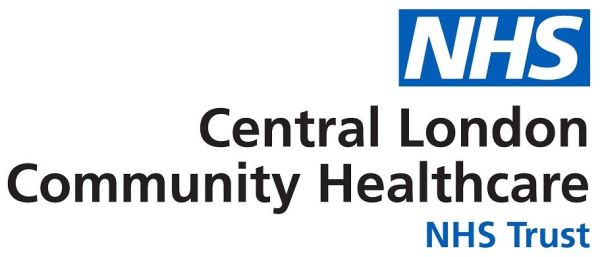Health visitors, community nurses and nursery nurses undertake the UNICEF Baby Friendly Initiative Breastfeeding training and can provide mothers and families with evidence based information and practical support to help you achieve your infant feeding goals. How you feed your baby is a personal choice and we are here to support you and your baby with whatever feeding choices you make and at any stage. This includes providing support and information about breastfeeding, mixed feeding, formula feeding and introducing solids at 6 months.
Infant feeding in Kensington, Chelsea, Westminster, Hammersmith and Fulham
Read more about this page below
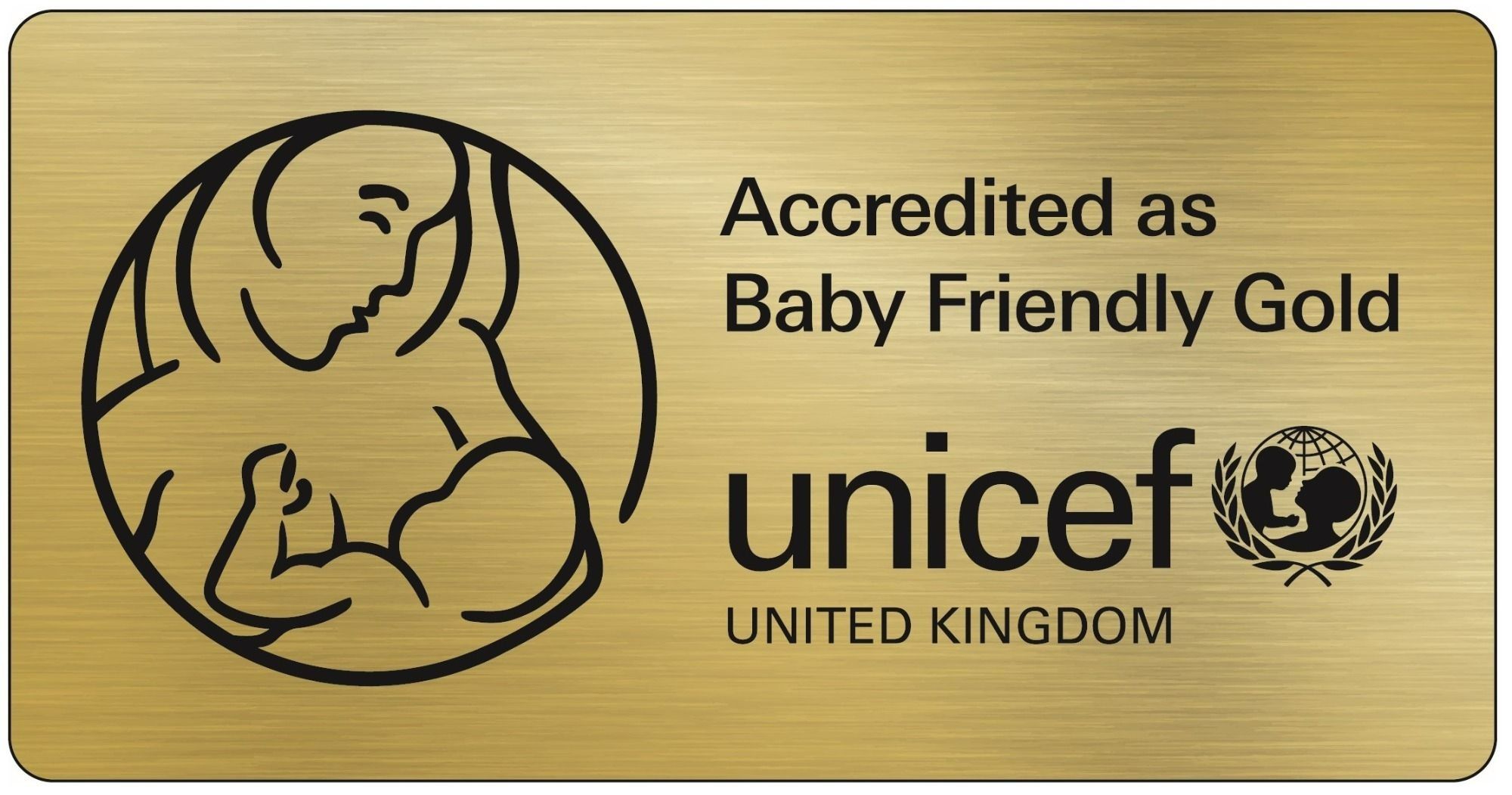
Support with feeding is offered by all members of the Health Visiting team at the new birth visit and any follow up contacts at home or in the child health clinic. A member of the Health Visiting Team will visit you at home between 10-14 days following the birth of your baby. Additional visits may be offered if required. A further contact will be arranged when your baby is 6 weeks old. The team will tell you know about the child health clinics, breastfeeding support groups and children's centres activities and other baby groups and sessions in your area.
Specialist breastfeeding support is offered in Infant Feeding Clinics and drop ins by a member of the health visiting team who has had additional experience and breastfeeding training. A member of the Health Visiting Team can book an appointment in the specialist clinic for you and your baby.
If you have any questions or concerns about feeding your baby please speak to a member of the Health Visiting team directly or call 0208 200 2500 (option 2).
Breastfeeding and infant feeding support groups:
| Westminster | Kensington and Chelsea | Fulham and Hammersmith | |
| Monday |
Queen’s Park Children’s Centre (W9 3AL, 020 7641 5838) Mum and baby drop in: 10.00 -11:30. Support for parents with babies 0-12 months & feeding support with a Maternity Champion NCT trained Peer Supporter. |
The Dalgarno Trust (W10 5QB, 020 8969 6300) Baby Wellness & breastfeeding support: 10:00-12.00. Term time only. Maternity Champion NCT trained Peer Supporter. |
Tudor Rose Family Hub & Community Centre (SW6 5PG, 020 8753 6070) Infant Feeding Clinic: 9:30-14:00.
|
| Tuesday |
Queen’s Park Health Centre (W10 4LD, 020 8964 9990) Breastfeeding support appointment via the health visiting team: 9:30 – 11:30. Run by the Health Visiting team |
The SPACE (W10 6TT, 020 8960 2889) Cheyne Children’s Centre (SW10 0ST, 020 7361 2202) Infant Feeding Clinic: 10:30-14:45pm. Appointment via Health Visiting team. Portobello Green Canopy (W10 5TD, 07961 232431) Buggy Walk with tea and cake: 11:00. With Maternity Champion NCT trained peer supporter. |
Joe & the Juice, 809 Fulham Rd (SW6 5HE, 07939 048212) Drop-in breastfeeding session: 10:00-12:00. Randolph Beresford Children’s Centre Annex (W12 7DE, 020 8743 7339) Breastfeeding clinic with Infant Feeding Midwife, Imperial NHS Trust. Referral via midwife or HV. For babies up to 28 days old only. Chelsea and Westminster Breastfeeding Drop in For women seen by C&W postnatally and up to 28 days- 10.00-12.00 no arrivals later than 11.30 Ground Floor Riverside Market, Fulham Pier, Craven Cottage, SW6 6HH (Entrance via Thames Path through Bishops Park or Stevenage Road) Babyzone at West Youth Zone |
| Wednesday |
Bessborough Street Family Hub (SW1V 2JD, 020 7641 5923) Baby & Me Drop in: 10:00-11:30. Support for new parents & breastfeeding support Church St Family Hub at Portman Early Childhood Centre (NW8 8DE, 020 3307 1940) |
Earl’s Court Stay & Play: 9:15-10:45. Breastfeeding support with Maternity Champion NCT trained peer Supporter. |
|
| Thursday |
Online Le Leche League feeding support. NHS feeding support drop in: 13:00-15:00.
Church St Family Hub at Portman Early Childhood Centre (NW8 8DE, 020 3307 1940) NHS feeding support drop in: 13:00-15:00.Run by St Mary’s Hospital. Contact Celeste on 07717 835279 if you would like to attend. For babies up to 28 days old only. |
Holmfield House (W10 5PE, 020 7938 8400) Online Le Leche League feeding support Chelsea and Westminster Breastfeeding Drop in: 12.30 to 14.30 |
Online Le Leche League feeding support Online feeding support: 13:00-14:30. Complete the online form for login details to be emailed to you http://bit.ly/LLLwestlondon Chelsea and Westminster Breastfeeding Drop in For women seen by C&W postnatally and up to 28 days- 12.30-14.30 at Masbro Centre, W14 0LR |
| Friday |
Church St Family Hub at Portman Early Childhood Centre (NW8 8DE, 020 3307 1940) The Stowe Centre (W2 5ES, 020 7266 8220) Queen’s Park Children’s Centre (W9 3AL, 020 7641 5838) NHS feeding support drop in: 13:00-15:00. Queen’s Park Children’s Centre (W9 3AL, 020 7641 5838) Breastfeeding clinic – Infant Feeding Midwife, Imperial NHS Trust Referral via midwife or HV. For babies up to 28 days old only. |
Chelsea Theatre (SW10 0DR, 07521 776101) Contact: zanderr@chelseatheatre.org.uk Clare Gardens Children’s Centre (W11 1EG, 020 7727 2725) NHS feeding support drop in: 10:00-13:00. Ollie’s House
|
Randolph Beresford Children’s Centre Annex (W12 7DE, 020 8743 7339) Breastfeeding Drop in: 10:00-12:00. |
| One to one support |
Maternity Breastfeeding Champions For activities & support: https://www.pdt.org.uk/events-calendar/ Bessborough Street Family Hub Catherine Drake Wilkes 07966 194597 cdrakewilkes@westminster.gov.uk |
Maternity Breastfeeding Champions For activities and support: https://www.venturecentre.org.uk/maternity-champions Breastfeeding support is available on request. |
Breastfeeding support is available on request: H&F Children Centres Alanna.Johnston@lbhf.gov.uk 07767 003550 / 0208 753 6070, or Chermaine on 07773 345208. Family Champions Peer Support Manager Christina 07825606 896 christina.ifil@lbhf.gov.uk |
| Westminster | Kensington and Chelsea | Hammersmith and Fulham |
|
Queen’s Park Children’s Centre 020 7641 5838 - 88 Bravington Rd, London W9 3AL Queen’s Park Health Centre 020 8964 9990 – Dart Street, London W10 4LD Bessborough Street Family Hub 020 7641 5923 - 1 Bessborough St, London SW1V 2JD Catherine Drake Wilkes cdrakewilkes@westminster.gov.uk Church St Family Hub at Portman Early Childhood Centre 020 3307 1940 - 12-18 Salisbury St, London NW8 8DE The Stowe Centre 020 7266 8220 – 258 Harrow Road, London W2 5ES |
The Dalgarno Trust 020 8969 6300 – 1 Webb Close, W10 5QB The SPACE 020 8960 2889 - 214 Freston Rd, London W10 6TT Cheyne Family Hub 020 7361 2202 - 10 Thorndike Cl, London SW10 0ST Portobello Green Canopy 07961 232 431 - Portobello Green, W10 5TD – under the Canopy Response Community Centre 020 3161 5909 - 300 Old Brompton Rd, London SW5 9JF St Cuthbert’s Children’s Centre 020 7373 8225 - Warwick Rd, London SW5 9UE Holmefield House Family Hub 020 7938 8400 - 4-6 Golborne Rd, London W10 5PE www.neighbourhooddoulas.org Chelsea Theatre 07521 776101 - 7 Worlds End Place, SW10 0DR Contact Jaya ccassistantmanager@chelseatheatre.org.uk Clare Gardens Children’s Centre 020 7727 2725 – 349 Westbourne Park Rd, London W11 1EG |
Tudor Rose Family Hub & Community Centre 020 8753 6070 - Shottendane Rd, London SW6 5PG Contact Alanna.Johnston@lbhf.gov.uk 07767 003550 / 020 8753 6070, or Chermaine Songui on 07773 345208. Joe & the Juice 07939 048212 - 809 Fulham Rd, SW6 5HE Contact: Yvonne Randolph Beresford Children’s Centre Annex New Zealand Way W12 7DE Contact Alanna.Johnston@lbhf.gov.uk or 020 8743 7339 |
National Breastfeeding Helpline: 0300 100 0212 (Available 24-hours a day/365 days a year)
La Leche League: 0345 120 2918 https://www.laleche.org.uk/find-lll-support-group/
Association of Breastfeeding Mothers: 0300 330 5433 https://abm.me.uk/
Breastfeeding Network: 0300 456 2421 9.30–21:30
Breastfeeding is a new skill for you and your baby to learn and it can take time for you both to get the hang of it. As with any new skill it takes practice to get it right
Preparing yourself for breastfeeding before your baby is born can help you to get your breastfeeding journey off to a good start.
Find out about breastfeeding while you are pregnant, look for a class or session that you would like to attend. Speak to your midwife or health visitor especially if you have any questions or concerns about breastfeeding.
At first your baby will want to feed all the time, they have tiny tummies and need to feed frequently, and this is what will help to set up your milk supply.
Your baby will feed for 5-40 minutes, 8-12 times a day so:
- Choose a place in your home where you would like to sit to breastfeed.
- Sit in a comfortable chair which offers support, sometimes in the early days a more upright chair can be helpful. Sitting in a more upright position means that you can see your breast and baby more clearly and therefore it can help with positioning and attachment.
- Make sure you have drinks, snacks and everything you need to hand as you will be spending a lot of time breastfeeding especially in the early days.
- Lay your baby against you, skin-to-skin, as often as you can. This will help baby’s natural reflexes to find and attach to the breast. Skin-to-skin helps to soothe your baby at any time, especially if they are unsettled before or during a feed.
- Let your baby breastfeed whenever they want, babies have tiny tummies so they can’t wait long between feeds.
- Bring your baby to the breast rather than putting the breast into baby’s mouth - let your breast hang at its natural level and avoid lifting it up or moving it, as once baby latches and you let go of the breast your baby may slip off.
- To start with nursing pillows might get in the way of positioning your baby effectively so tuck in pillows or cushions for support after your baby has latched to support your arms and back.
- Feeding at night is important in the early weeks to help establish and maintain your supply. This is because the milk making hormone (prolactin) is highest at night time. When baby feeds during the night, they help to set up a good supply of milk for the next day.
- Sleep and rest whenever you can, just lying down and relaxing will help to restore your energy levels.
- Ask visitors to bring a meal or pick up some shopping for you and your family and ask them to visit at times which will fit in with you and feeding your baby.
This series of films by Global Health media cover all aspects of feeding your baby: Breastfeeding Videos - Global Health Media Project
Resources from the Baby friendly Initiative about infant Feeding relationship Building and common feeding challenges: Support for parents - Baby Friendly Initiative
Information about breastfeeding in different languages:
UNICEF: Breastfeeding guides in other languages
Global health media videos on all aspects of breastfeeding in other languages.
Positioning your baby for Breastfeeding
Positioning your baby effectively will enable them to able to attach to the breast.
You can feed your baby in any position that feels comfortable. You may find at first that you prefer one position, but as you and your baby become more confident with breastfeeding you will be able to try different positions.
Get yourself and your baby ready to feed in response to early feeding cues. It is much easier for babies to latch effectively when they are calm and relaxed.
Achieving an effective latch is essential for baby to be able to drink milk from the breast and to ensure your nipples don’t get sore. The acronym CHINS is a reminder of the key principles of positioning - each letter stands for the way you position your baby which will help them to attach (latch) to the breast. Remember your breasts are like sisters not twins and one can be bigger or higher or lower than the other, so you may need to position your baby slightly differently for each breast:
C = Close Baby’s body should be held close to you, so they can easily reach the breast
H=- Head free Baby’s head is free to tilt back with no fingers or hands holding the back of their head. This will allow them to open their mouth wide and take a big mouthful of breast to achieve a deep effective latch.
I = In line When looking down at your baby, you will see the ear shoulder and hip in a straight line. This will ensure baby is comfortable and help them stay close and attached to the breast
N = Nose to nipple Positioning baby with your nipple pointing to the tip of their nose (not beyond the nose) will mean that your baby will be at the level of the nipple so when they open their mouth wide the nipple will be pointing to the back of the roof of their mouth which is where it should be when they attach and are feeding. If you position the nipple in line with babys mouth the nipple will hit their tongue and the latch will be painful and shallow and will affect feeding.
S =Sustainable: Make sure you are comfortable and have a drink and snack and everything you need before you start feeding as your baby could feed for up to 40 minutes.
The way to position your baby to help them attach effectively to the breast can be seen in these films:
- Positioning and attachment video - Baby Friendly Initiative (unicef.org.uk)
- Positions for Breastfeeding - Video - Global Health Media Project
Your baby is ready for you to quickly move them onto the breast when:
- Their mouth is open wide like a yawn so they can take a big mouthful of breast = a deep effective latch
- Their head is tilting back with the nipple pointing to the rear of the roof of the mouth so when they attach the nipple is far back in their mouth = a deep effective latch
- With the head tilting back their chin will touch the breast first
- Then the bottom lip will touch the breast away from the base of the nipple so baby can get a big mouthful of breast so that the nipple will be at the back of the roof of the mouth = a deep effective latch
The way your baby attaches to the breast can be seen in these films:
- Positioning and attachment video - Baby Friendly Initiative (unicef.org.uk)
- Attaching Your Baby at the Breast - Video - Global Health Media Project
Signs that tell you that your baby is effectively attached.
- Baby’s mouth is open wide
- Baby’s chin is indenting the breast
- Cheeks are rounded because there is breast in their mouth not just the nipple - you shouldn’t see dimples in their cheeks– this suggests that the latch may be shallow
- Usually you can see more of the darker area around the nipple (areola) above the top lip
- At first there will be rapid sucks to stimulate the “let down” followed by slower rhythmical swallows as the milk starts to flow
- You can hear and feel baby swallowing milk and getting milk out of the breast
- Baby is calm and settled and stays on the breast and comes off on their own when they have finished feeding
- Feeding is comfortable and pain free for you
- Your nipple shouldn’t be pinched, flattened or look like a new lipstick at the end of the feed – this suggests that the latch is not deep enough and the nipple is being pinched during feeding
Below is the checklist our health visiting teams use to check that feeding is going well and identify any areas where you may need additional help. You can use them too:
If feeding is uncomfortable:
- Take baby off the breast by using a clean finger in the side of baby’s mouth to break the suction and try to latch again
- It can take time and patience to get an effective latch – you are both learning a new skill
- Skin-to-Skin is a great place to start to soothe your baby at anytime but especially before feeding
- Ask your midwife or health visitor for help if feeding is uncomfortable
For information about hand expressing and storage of breast milk:
Below is a guide about how to increase your milk supply. If you would like help or advice with this please speak to your Health Visiting team.
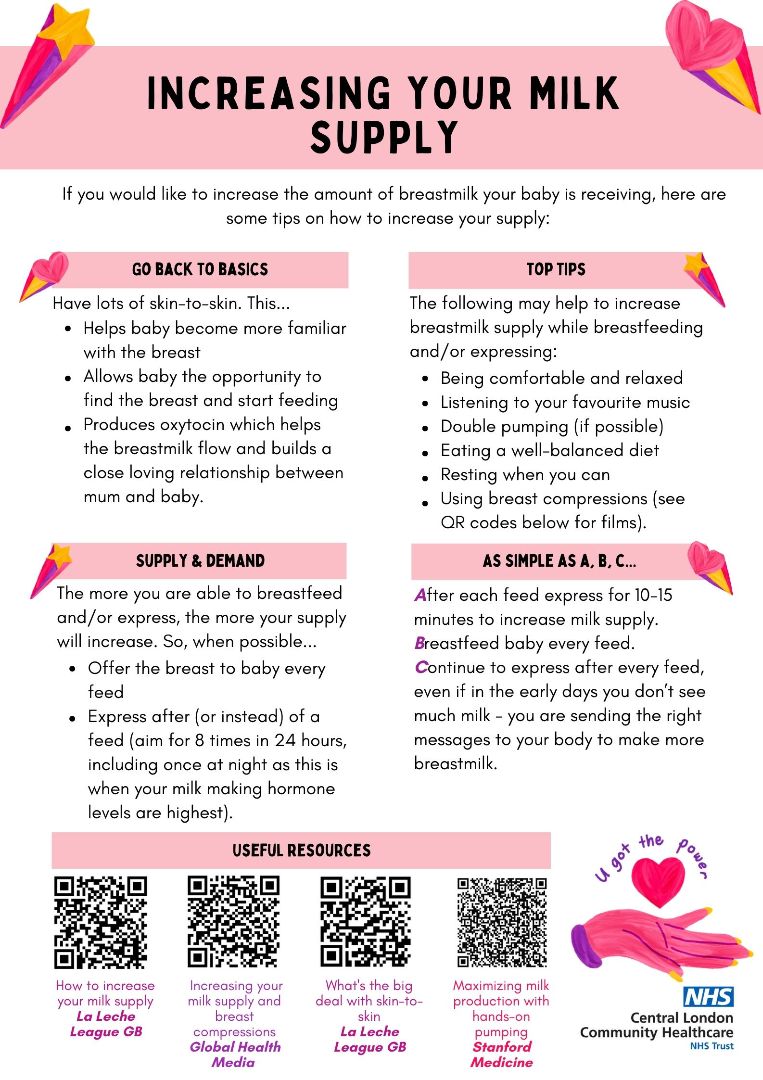
Information about breast feeding while taking medication:
For information about responsive bottle feeding and formula milk:
- Responsive bottle feeding and Infant Formula
- Better Health Start for Life Guide to bottle feeding
- Information about formula prep machines, hot taps and baby kettles
Below is the checklist our health visiting teams use to check that feeding is going well and identify any areas where you may need additional help. You can use them too:
For bottle feeding guidance in different languages:
Information about your baby's brain development:
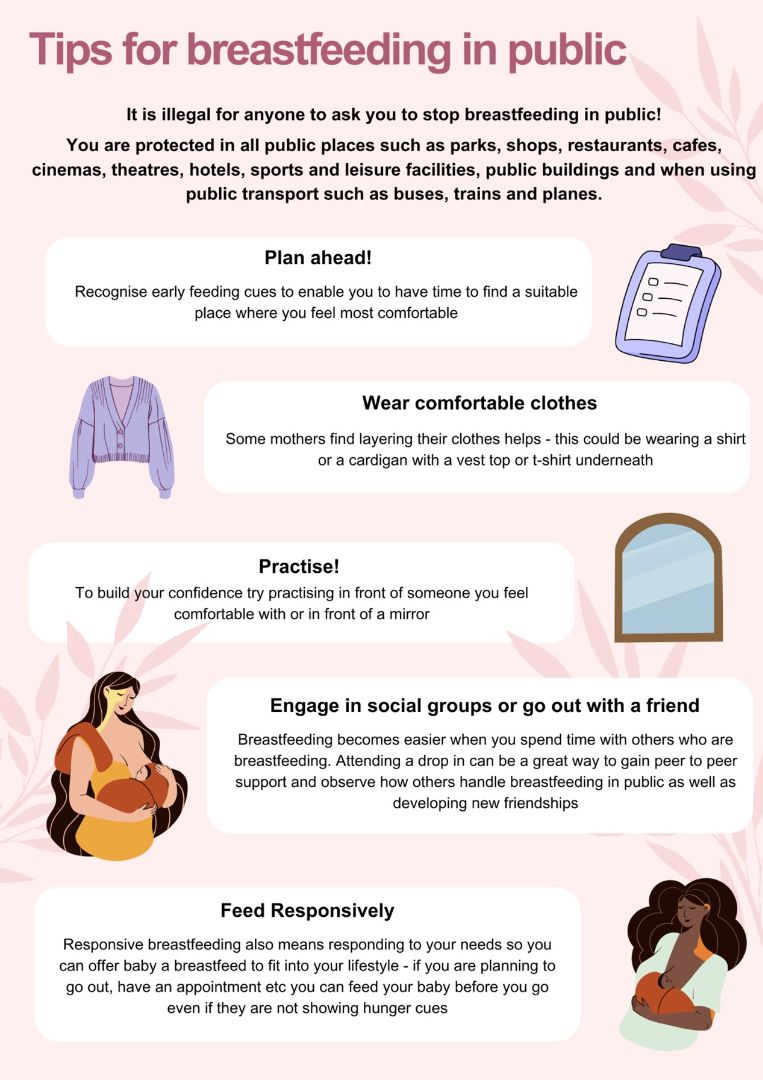
For more information please visit the NHS guidance on breastfeeding in public and breastfeeding while out and about on the Maternity action website.
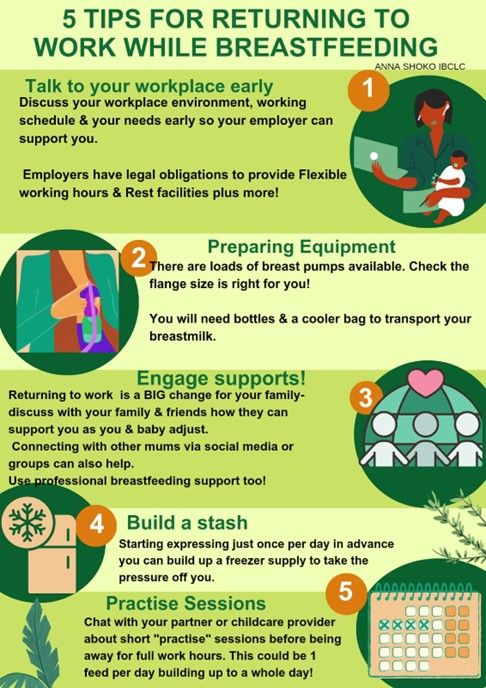
You don’t need to stop breastfeeding just because you’re returning to study or work. Many women find ways to continue breastfeeding their baby – and employers have certain obligations towards breastfeeding women.
For health reasons, it is recommended that babies are fed solely on breast milk or infant formula for the first six months.
Here are some helpful resources to support you and your baby with introduction to solid foods:
- CLCH Introduction to solids leaflet
- Eating well in the first year - First Steps Nutrition
- First Steps Nutrition Eating Well Resources
- Watch Introduction to solid foods video
If you have any questions about introducing solids to your baby visit a child Health Clinic or to speak to a member of the health visiting team contact the duty line on 0208 200 2500 option 2.
If you live in Westminster or Kensington & Chelsea the Change4Life Service offers two 2 hour workshops about introducing solids which is free to attend. Ask your health visitor or contact your local Children Centre to find out more.
Please check the NHS Healthy Start website to see if you are eligible to receive free vitamins and money to buy healthy foods and milk. You could be eligible to receive £4.25 per week during pregnancy and continued payments until your child is 4. Visit the NHS Healthy Start website to find out more.
If you are eligible for Healthy Start you can collect your free Healthy Start Vitamins at any Children Centres (bring your Healthy Start Card):
Infant crying is normal and it will stop.
A baby’s cry can be frustrating upsetting and you may be worried that something is wrong with your baby. Your baby is crying because they want your attention. Your baby may start to cry more frequently at about 2 weeks of age. As you can see in the normal crying curve the crying may become more frequent and last longer during the next few weeks, hitting a peak at about 6 to 8 weeks. This phase will stop.
Every baby is different, but after about 8 weeks, babies start to cry less each week. Responding to your baby will help to calm and soothe them
- Keep your baby close and have skin to skin contact
- Gently rock your baby in your arms in the position in which they like
- Talk or sing to your baby or let them hear a repeated or soothing sound
- Feed your baby in response to cues if breastfeeding - offer your baby the breast when they are unsettled, distressed, or want to be close to you as well as when they show signs of hunger.
- Give your baby a warm bath
- Keeping your baby close, and if breastfeeding offering the breast, can help settle your crying baby after immunisations, if your baby is unwell or to reassure them in an unfamiliar environment.
- Go for a walk with your baby
These techniques may not always work. It may take time and a combination or more than one attempt to soothe your baby. For more information click on the links below:
CRY-SIS - National Help Line: 08451 228669. Lines open 7 days a week, 9am-10pm.
Coping with a crying baby: Infant crying and how to cope
Remember – if you are concerned that your baby may be unwell, contact your GP or NHS 111 (go to 111.nhs.uk or call 111- the service is available 24 hours a day, 7 days a week). In an emergency, ring 999.
For more information about Safer sleep for babies to reduce the risk of sudden infant death syndrome (SIDS, previously known as cot death):
For information about baby sleep products and baby sleep product safety:
Baby sleep information source (Basis) You can download the Basis app where you can find further information on safe sleeping practices for you and your baby.
CLCH have produced a video about normal sleep and how to promote sleep in the antenatal period as well as the postnatal period, up to the first six months.
Click on the baby-sling safety webpage for the TICKS rule for safe baby wearing and use of slings factsheet.
It is important to note that is not safe to breastfeed your baby while in a sling. Breastfeeding in a sling is incompatible with the TICKS guidance. If breastfeeding baby in a sling their head can be tilted forward and their face may be squashed into the breast covering their mouth and nose which can block their airway so they will not be able to breathe.
Watch this film, Feeding in Slings and Carriers - Safety considerations and how to do it, for more information about using slings and baby carriers safely.
The health visiting team will let you know about the baby clinics, activities and sessions for babies and children that take place in the Family Hubs (children centres) in your area.
You can find out more in the Family Hub in links below:
- Family Hubs Westminster: Family Information Hub | Westminster Family Hubs
- Family Hubs Kensington & Chelsea Family Information Hub | Family Hubs locations and timetables
- Family Hubs Hammersmith & Fulham The Family Hub | London Borough of Hammersmith & Fulham
